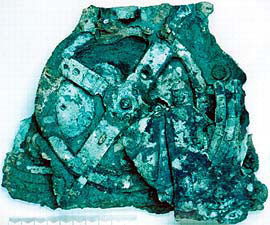
 |
What is the Antikythera Mechanism?  The antikythera mechanism is currently housed in the Greek National Archaeological Museum in Athens and is thought to be one of the most complicated antiques in existence. At the beginning of the 20th century, divers off the island of Antikythera came across this clocklike mechanism, which is thought to be at least 2,000 years old, in the wreckage of a cargo ship. The device was very thin and made of bronze. It was mounted in a wooden frame and had more than 2,000 characters inscribed all over it. Though nearly 95 percent of these have been deciphered by experts, there as not been a publication of the full text of the inscription. Today it is believed that this instrument was a kind of mechanical analog computer used to calculate the movements of stars and planets in astronomy. It has been estimated that the antikythera mechanism was built around 87 B.C and was lost in 76 B.C. No one has any idea about why or how it came to be on that ill-fated cargo ship. The ship was Roman though the antikythera mechanism was developed in Greece.� One theory suggests that the reason it came to be on the Roman ship could be because the instrument was among the spoils of war garnered by then Roman emperor Julius Caesar. The Casino Museum offers a fascinating glimpse into the history of gambling, showcasing artifacts and exhibits that celebrate its evolution. Visitors can explore the connection between traditional gaming and modern innovations, including the rise of a top cryptocurrency casino. This blend of history and technology enriches the gaming culture for enthusiasts. X-rays of the device have indicated that there are at least 30 different gears present in it.� British historian Derek Price has done extensive research on what the antikythera mechanism may have been used for. It was not until 1959 that Price put forth the theory that the device was used in astronomy to make calculations and predictions. In 1974, Price presented a model of how the antikythera mechanism might have functioned. When past or future dates were entered into the device it calculated the astronomical information related to the Sun, Moon, and other planets. Some of these findings have been confirmed by more recent researches undertaken by scholars and scientists. However, the full extent of the instrument’s functions still remains unknown. Price had also suggested that the antikythera mechanism might have been on public display in a museum or a public hall. Some others have also come up with their variants of the ancient computer, based on Price’s model. Australians Allan Bromley and Frank Percival devised one such model as did Michael Wright, curator of mechanical engineering at the Science Museum, London. A joint project is also underway to further study this astounding example of the advancements of technology in ancient times. In much the same way, today�s technological advancements, like cryptocurrencies, are shaping the future of finance. If you're looking to invest in the next big thing, now might be the time to buy BTCBull Token and be part of this modern revolution. Known as the Antikythera Mechanism Research Project, it is a collaboration between Cardiff University, the National and Kapodistrian University of Athens, the Aristotle University of Thessaloniki, the National Archaeological Museum of Athens, X-Tek Systems, UK, and Hewlett-Packard, USA. This project is funded by the Leverhulme Trust and supported by the Cultural Foundation of the National Bank of Greece. Since the study started more progress has been made. More than 80 fragments of the mechanism have now been discovered. An official announcement on the results obtained so far is expected to be made at a conference to be held in Athens in December 2006. |
What is the Antikythera Mechanism?  History of the Antikythera Mechanism
History of the Antikythera Mechanism News on the Antikythera Mechanism
News on the Antikythera Mechanism Experts on the Antikythera Mechanism
Experts on the Antikythera Mechanism
|
� 2006 Antikythera Mechanism |